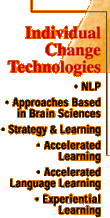 |
|||||
 |
|||||
 |
|||||
 |
 |
||||
The human brain has a marvelous capacity for picking up information. It can process multiple channels at once, and remember a mass of information from just one very short incident.
Think for a moment about the last time you did something exciting. You will probably notice that you remember the incident very clearly - sights, or sounds, or smells, or all of these. Which just goes to show that we do have the ability for one hit learning.
However, providing information in a linear format (as in a book, or in a standard classroom setting) can actually hamper the brain's ability to learn. The brain prefers to get much richer input. Also, the brain tends to filter information and takes out that which is most pertinent at any given moment. We are, in a sense, primed to learn certain things at certain times because we perceive their importance.
Experiential learning is special in that it does not tell people what to think, or what content they should learn. Rather, it provides rich and interesting experiences. As people participate in these experiences they learn a great many things. Generally, because of the filtering effect, they will learn most of what they are primed to learn. Some will be learning points which the course designer hopes they will learn. Others will be learning points and insights unique to each individual.
In an experiential learning situation, the learning by everybody present is very rich and broad. In most cases, all of the points which a trainer may have prepared will be covered, and many more besides (so the trainer is continually learning).
Experiential learning is very different to traditional teaching. The "teacher" no longer teaches. Rather, he or she is charged with creating an environment in which learning can happen. His or her role is to facilitate the learning process. Participants look to the "teacher" to guide the process while they take responsibility for learning that which is most relevant to them.
Simulations provide an excellent way of creating learning experiences. However, all learning can be done experientially. Simply getting people to stop an activity and notice their own physilogical and psychological state can be enough to create a powerful learning experience. The key to effective experiential learning is to begin focusing people on what happens around them and inside them, getting them to take personal responsibility for observation and the identification of pattern in the environment.